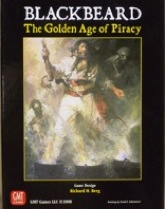Blackbeard: The Golden Age of Piracy Boardgame
 Blackbeard: The Golden Age of Piracy. GMT Games. Designed by Richard H. Berg. $55.00.
Blackbeard: The Golden Age of Piracy. GMT Games. Designed by Richard H. Berg. $55.00.
The end goal is to accept a Letter of Marque from one of the major world powers and retire to a port of that nationality, turning respectable to enjoy a sea dog’s final years.
Passed Inspection: Excellent multiplayer game combining strategy with resource management.
Failed Basic: Straddles the line between family board game and wargame.
Pirates have been a popular topic in games ever since the Johnny Depp Pirates of the Caribbean franchise set its swaggering box office records. The so-called Golden Age of Piracy was indeed a remarkable period in history, and the re-release by GMT Games of Blackbeard, a former The Avalon Hill Game Company title, brings a versatile favorite back into the fold.
{default}In Blackbeard, players select three pirates at random from the stack of pirate cards and must learn to live with those historical characters’ strengths and weaknesses. The pirates themselves have six abilities that come into play at different times of the game: Initiative; Ability; Leadership; Cruelty; Cunning and Duel. Players may also choose to draw new pirates from the Pirate deck and add them to their roster in later turns.
Players then choose one or more of their pirates to set sail for missions of plunder and pillage. Pirates may attack ships and ports, though they will quickly earn the enmity of the colonial governments, and may find sacking similarly aligned ports to be much more difficult after the first such raid. Combat is resolved with dice rolls; the port or ships combat/defensive value plus a die roll vs. the pirate ship’s combat value and the pirate captain’s leadership rating plus a die roll. If the pirate wins, he collects treasure and possibly hostages. The latter can be ransomed later or tortured for information that will give the pirates an attack bonus against neighboring ports. Buccaneers wishing to cash in their treasure may do so at any friendly port, but pirate ports tend to pay the best return on such exchanges. One one-hundredth (1/100th) of the money “cashed in” goes towards the pirate’s victory point total.
Much of the action of this game is driven by the deck of Event Cards. Players may choose to use an Event Card to initiate its event or for the Action Points it can generate. Moving a pirate’s ship marker from one sea area to an adjacent sea area costs one action point, as does moving from a sea area to a port, or attacking a port or ship. A pirate’s initiative is the number of actions the player can take in a turn. Some event cards may be played out of turn, such as Warship Sighting, which allows the player to place a randomly drawn warship in the sea area where the current player’s ship has declared an attack or a loot action.
The end goal is to accept a Letter of Marque from one of the major world powers and retire to a port of that nationality, turning respectable to enjoy a sea dog’s final years in comfort and peace. This is easier said than done, of course, as there are a limited number of Letters of Marque cards in the deck, and in a moment of desperation the action points that card provides may be more immediately useful than the event itself. Another catch is that said retirement must be performed at a port with a pro-piracy governor; otherwise the pirate can be assured of only one thing: a short drop and a sudden stop. Governors are occasionally replaced per Event cards, so those that are more well-disposed toward the bretheren of the sea become scarce in short order.
A game of Blackbeard ends when the General Pardon card comes up for the third time. After its first and second appearances, the card is reshuffled into the remaining Event Card deck, hastening its reappearance.
This game is neither fish nor fowl, falling somewhere in the middle between wargame and family boardgame, and gamers expecting it to be exclusively one or the other might be disappointed. It is enjoyable, though, and offers great flexibility. Designed as a game for two-to-five players, its rulebook provides modifications that allow up to 10 peg-legged freebooters per game. Other rule modifications allow for solitaire play.
Those who didn’t pick up this gem when it first appeared back in the 1990s should be glad for the second chance. Blackbeard isn’t a difficult game to learn, and there’s elegance to the design that gives players enormous flexibility in their actions— always the mark of a good board game.
Bill Bodden has been in the hobby game industry for over twenty years, including stints in the retail, distribution and publishing sectors. His fiction was nominated for an Origins Award in 2003 for fiction, and he contributed to the Origins Award-winning book Hobby Games; The 100 Best. He currently serves as sales manager for Green Ronin Publishing, and is a part-time freelance writer. A complete goober for miniatures, he paints them on rare occasions when he has spare time. Bill lives in Wisconsin with his wife, their four cats, and a whole lot of games.
[gallery:168]

Great review!
So great, that it even served for the last 50% of Jeff McAleer’s Oct. 2010 review of “Blackbeard” on The Gaming Gang… but I think he forgot to credit Armchair General:
http://thegaminggang.com/our_reviews/tabletop-gaming-reviews/yo-ho-yo-ho-a-review-of-blackbeard/
Crew Loyalty for Armchair General: +1
Crew Loyalty for TGG: -1
Thank you for letting us know. Glad you liked the review and thanks again for the heads up.